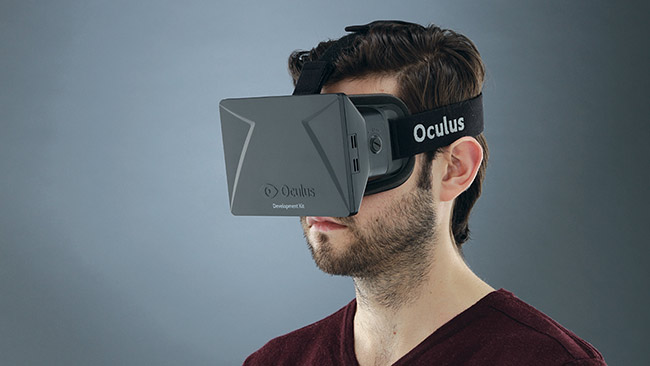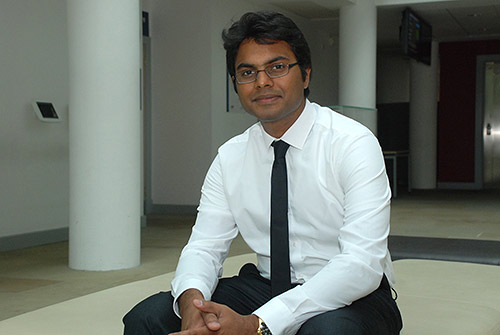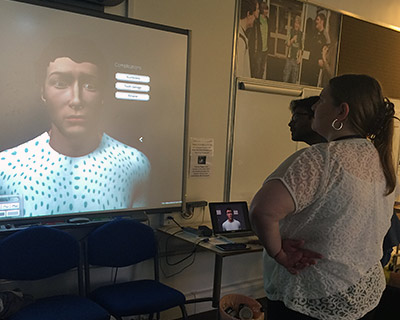Research uses virtual reality technology to train dental surgeons
 Yeshwanth Pulijala's PhD project aims to provide trainee surgeons with close-up, unrestricted, 360-degree views of a surgical procedure that have the potential to be a massive improvement on the operating room sessions in surgical training.
Yeshwanth Pulijala's PhD project aims to provide trainee surgeons with close-up, unrestricted, 360-degree views of a surgical procedure that have the potential to be a massive improvement on the operating room sessions in surgical training.
Mon, 10 Aug 2015 01:00:00 BST
PhD Researcher Yeshwanth Pulijala harnesses 3D visualisation to help oral and maxillofacial surgical trainees to perform complex medical procedures
 A UNIVERSITY of Huddersfield researcher is harnessing the very latest virtual reality technology to train surgeons. The project aims to provide accurate graphical visualisations of human anatomy and surgical procedures via state-of-the-art headsets.
A UNIVERSITY of Huddersfield researcher is harnessing the very latest virtual reality technology to train surgeons. The project aims to provide accurate graphical visualisations of human anatomy and surgical procedures via state-of-the-art headsets.
Indian-born Yeshwanth Pulijala (pictured right) is a fully-qualified dental surgeon. During his own training he was confronted by the problem of poor visualisation in the operating room. This awareness of shortcomings in surgical training, allied to a passion for 3D design and technology led him to relocate to the UK for postgraduate research that aims to make breakthroughs in the use of advanced technology to improve healthcare.
First came a Master’s degree in 3D medical visualisation at University of Glasgow. He created a mobile app called SurFace that provides patient education in corrective jaw surgery. This inspired him to explore the potential of virtual reality for surgical education, using a highly-advanced headset, Oculus Rift. A commercial version of this is expected to be released in the first quarter of 2016, but Yesh – now studying for a PhD at the University of Huddersfield – has managed to get his hands on the developer version for his research.
Learning through observation and hands-on participation are important aspects of education for surgical trainees, medical and dental students. “During these sessions the trainees learn by observing the procedures in real time,” said Yesh.
 Pictured left at the Joint Conference on Serious Games, which was hosted by the University, Yesh is showing a delegate how his game, called SurFace, will help oral and maxillofacial surgical trainees perform complex medical procedures.
Pictured left at the Joint Conference on Serious Games, which was hosted by the University, Yesh is showing a delegate how his game, called SurFace, will help oral and maxillofacial surgical trainees perform complex medical procedures.
“But the problem is that not everybody can see what is happening. This is especially the case in crowded operating rooms where surgical trainees perform multiple duties. Also in surgeries confined to oral and maxillofacial zone, as the structures are complex and densely enclosed in a confined space, it is very hard to observe and learn.
“Further, a reduction in surgical training hours is severely affecting the training of surgeons.”
As result, he continued, four-out-of-ten surgical trainees are not confident in performing the procedure. So he is developing a tool which helps them to virtually participate in an operation. His PhD project aims to provide trainee surgeons with close-up, unrestricted, 360-degree views of a surgical procedure that have the potential to be a massive improvement on the operating room sessions in surgical training.
“If you are a trainee surgeon, wearing an Oculus Rift, you will see the surgical procedure in an operating room environment and also able to ‘touch’ the skull of the patient and interact with it,” says Yesh.
 During his Masters, Yesh met one of his current supervisors, Minhua Ma (pictured right), a pioneer in the application of serious games technology for healthcare. She is now Professor of Digital Media and Games in the University of Huddersfield’s School of Art, Design and Architecture, where Yesh has access to facilities such as high-performance computers and advanced cameras to aid his research and development.
During his Masters, Yesh met one of his current supervisors, Minhua Ma (pictured right), a pioneer in the application of serious games technology for healthcare. She is now Professor of Digital Media and Games in the University of Huddersfield’s School of Art, Design and Architecture, where Yesh has access to facilities such as high-performance computers and advanced cameras to aid his research and development.
His second PhD supervisor is Ashraf Ayoub, who is Professor of Oral and Maxillofacial Surgery at the University of Glasgow’s Dental School. Professor Ayoub’s key role in the project will be to guide the research in creating high quality footages of operations, ensure their accuracy when incorporated into Oculus Rift and test their impact on surgical training.
Having established the need for his product, Yesh now moves on to developing the concept and producing working prototypes. In the longer term, he can envisage technology that enables surgical trainees to learn and carry out virtual operations via innovative technology.
“But at the moment it is about creating a high-quality visualisation, interacting with the patient’s data and seeing their anatomy in great detail.”







